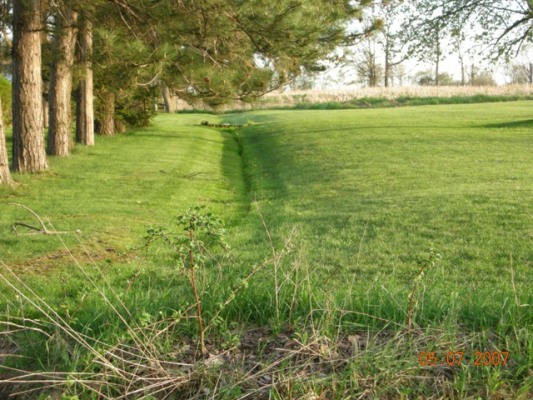Drainage
Farm drainage manipulation in the United States began with experiments with tile pipes conducted in neighboring New York State starting in the 1830s. These tiles channeled water away from the fields and into streams, rendering the land more workable and productive. Advocates made extravagant claims for underdrainage, ranging from heating up the soil, to making roads more passable, even to making farm life more attractive.
By the late nineteenth century, there were thousands of miles of tile lined, stone lined, and open ditch drains in the mid Atlantic and midwest. Early digging was with hand labor, but by the late nineteenth century steam-power trenchers came on the market, followed by gasoline power. In the post-World War II period, farm drainage accelerated significantly, owing to government programs subsidizing farm drainage; more powerful equipment; and vigorous promotion by the agricultural establishment, particularly the Soil Conservation Service and the Agricultural Extension Services. Historian Anne Vileisis estimates that by 1955 there were more miles of publicly supported drainage projects than miles of highway in the US.
By the mid twentieth century, contradictions in Federal postures towards wetlands were coming to a head. Agriculture remained one of the largest agents in reducing wetland areas in the United States. The US Department of Agriculture was heavily engaged in supporting drainage, even subsidizing farm drainage projects, while other agencies (Fish and Wildlife Service, for instance) began trying to preserve wetlands. Wildlife advocates and conservationists pointed out that subsidizing drainage had huge environmental impacts, ranging from flooding problems to loss of wildlife habitat. Legislation protecting wetlands was passed, and though it was unevenly enforced, impediments to farm drainage projects became more common.
Recognizing farm drainage features can be a challenge. In a 1908 book, Charles G. Elliott, Chief Drainage Engineer of the USDA, explained that there were two basic categories of farm drainage system: open ditches and underdrains. The heavy labor and expense of these features, not to mention the fact that they reduced farm land area, seems to have made them rather uncommon until power machinery and subsidies made them more affordable.
Underdraining was made by opening ditches, then laying drainage materials in them. Some underdrains were constructed of stone, but these were enormously labor intensive. Tiles were far more popular. These tiles were typically round pipes (early ones made of clay, later ones of cement and still later of plastic), and the water would seep into them at the joints, and from specially constructed surface inlets. Once the tiles were in, the ditch was backfilled. These seem to have been more popular than open ditches, because land area could be maintained, and advocates claimed fewer problems with obstructions. Once buried, these lines would not necessarily be easy to detect (in fact, unless they kept maps, farmers themselves sometimes lost track of their whereabouts). But there might be accompaniments that would appear on the landscape. These would include surface inlets; outlets; catch basins; and silt basins.
For more about farm drainage, see Ann Vileisis, Discovering the unknown Landscape: a History of America's Wetlands (1997).

Drainage Ditch, Mercer County, date unknown.